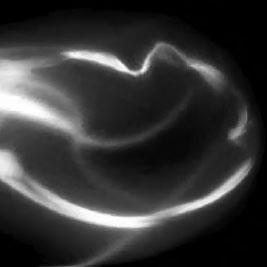Unanswered QuestionsBeyond the Proton, Neutron, and Electron |
What are possible replacements or additions to the Standard Model? |
One proposed replacement is called supersymmetry. Each boson in the standard model has a supersymmetric fermion partner particle (or sparticle). And each fermion has a supersymmetric boson sparticle. They are called sleptons, squarks, glunios, and photi-nos. These sparticles must be much more massive than the Standard Model particles (at least 480 billion electron volts). At this time there is no direct evidence of their existence, although the LHC might be able to reach high enough energies to find them.
A second replacement is string theory. String theory requires a ten-dimensional space-time rather than the normal four-dimensional space-time (three spatial dimensions and one time dimension). A string is a tiny closed loop (like a rubber band). In some theories the loop can break into an open length (like a piece of yarn) but in others it cannot. Strings vibrate at characteristic frequencies, like guitar strings. Each vibration frequency corresponds to an elementary particle. If a string theory is to include fermions (quarks and leptons) supersymmetry must exist.
The great advantage of string theory is that the graviton, the particle that carries the gravitational force, is naturally accommodated. But, if string theory is to be a theory of quantum gravity then the size of a string must be the size of the so-called Planck length, 1.6 x 10-35 m! That is an unimaginably small length, 10-20 as large as a proton. String theories, however, contain symmetries that make their effects felt at larger distances. At this time there is no experiment that could test string theory. If supersymmetric particles are found, then string theory may garner more support.

